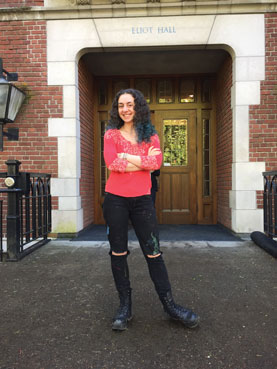
IRIS login | Reed College home Volume 96, No. 2: June 2017
Eliot Circular
Chem major battles malaria parasite

For her senior thesis, chemistry major Rose Gonoud ’17 squared off against one of humankind’s most ancient and implacable adversaries: Plasmodium falciparum, the parasite that causes malaria.
Plasmodium is a truly diabolical foe, responsible for the death of more than 400,000 people every year, according to the World Health Organization. It also has an extraordinary ability to mutate, developing resistance to many of the drugs currently used to fight it.
One technique for overcoming this resistance is to start with an old drug and fine-tune it to attack the newer strains of the parasite. Rose focused her research on decoquinate (DQ), a drug developed in the 1960s to combat bacterial infections in chickens. Last year, researchers made the surprising discovery that DQ is also effective against malaria, making it an attractive candidate for drug development. Unfortunately, there’s a problem. DQ is insoluble—it doesn’t dissolve in the bloodstream, making it impossible to deliver the drug to the organs where the parasite usually hangs out. Rose’s mission was to see if she could find a way to make the drug more soluble without sacrificing its malaria-killing power.
Rose grew up in upstate New York and came to Reed intending to major in psychology. “I was bad at chemistry in high school,” she chuckles. “It was my Achilles heel.” But her attitude about the discipline was transformed after taking intro chem with Prof. Arthur Glasfeld [chemistry 1989–]. Last summer she did a medicinal chemistry internship with Gilead Sciences in Seattle, and she wanted to explore the field for her thesis project.
Prof. Alan Shusterman [chemistry 1989–] suggested she work with Aaron Nilsen [chemistry 2012–13], a former visiting professor at Reed, who now does malaria research at Oregon Health and Science University across the river. “I knew immediately that I wanted to do this,” she says.
DQ operates by latching onto a protein in the parasite’s mitochondria—its microscopic power supply. This interrupts the electron transport chain, a key energy production pathway, and gums up the germ’s ability to synthesize ATP. “The plasmodium just runs out of gas,” she says.
As she dug into her project, Rose realized that there were actually three reasons why DQ is insoluble. The first is something that earlier researchers had noticed: the DQ molecule consists of a quinolone core and a long tail that is hydrophobic, or greasy—and as every dishwasher knows, grease won’t dissolve in water. But there are other reasons, too. The core also contains an open hydrogen bond, which tends to attract other DQ molecules, forming big clumps that don’t mix with water. Finally, the core features central rings that also tend to make DQ molecules cling to each other in an interaction known as “pi stacking.”
Rose began to suspect that the hydrogen bonding and the pi stacking were even more important to DQ’s insolubility than the greasy tail. And she realized something else—“This was fixable,” she says.
Starting in the fall, she used chemical ingenuity to tinker with the structure of the core. After several months of intensive effort, Rose succeeded in synthesizing three new derivatives of DQ. Then came the showdown: how would they fare against the plasmodium?
Rose injected the derivatives into test tubes filled with blood teeming with parasites, and anxiously waited for the results. The first compound was a dud. But the other two proved both soluble and effective at killing the plasmodium. In fact, DQ-337 actually turned out to be more lethal to the germ than DQ.
“I was elated,” Rose says. “There was a lot of excitement in the lab, I remember thinking I had gotten very lucky.”
“This is great work,” says her thesis adviser, Dr. Nilsen. “It’s pretty impressive.”
The DQ compounds that Rose developed are not silver bullets; they are probably not effective enough to be used in the field. But interfering with the plasmodium’s electron transport chain is going to be a key strategy for developing the next generation of antimalarials, Nilsen says.
For her part, Rose says the journey has been exhilarating. “It’s been a lot of fun,” she says. Researchers in the lab are now looking at other ways to shut down the plasmodium. In fact, several other Reed grads are working on the project at OHSU, including Alina Krollenbrock ’12, Emma Farley ’13, and Lisa Frueh ’15.
Rose hopes to join them after graduation.

LATEST COMMENTS
steve-jobs-1976 I knew Steve Jobs when he was on the second floor of Quincy. (Fall...
Utnapishtim - 2 weeks ago
Prof. Mason Drukman [political science 1964–70] This is gold, pure gold. God bless, Prof. Drukman.
puredog - 1 month ago
virginia-davis-1965 Such a good friend & compatriot in the day of Satyricon...
czarchasm - 4 months ago
John Peara Baba 1990 John died of a broken heart from losing his mom and then his...
kodachrome - 7 months ago
Carol Sawyer 1962 Who wrote this obit? I'm writing something about Carol Sawyer...
MsLaurie Pepper - 8 months ago
William W. Wissman MAT 1969 ...and THREE sisters. Sabra, the oldest, Mary, the middle, and...
riclf - 10 months ago